Photobiomodulation for non-exudative age-related macular degeneration
- PMID: 34097768
- PMCID: PMC8273038
- DOI: 10.1002/14651858.CD013029.pub2
Photobiomodulation for non-exudative age-related macular degeneration
Abstract
Background: Age-related macular degeneration (AMD) is one of the leading causes of blindness in high-income countries. The majority of cases of AMD are of the non-exudative type. Experts have proposed photobiomodulation (PBM) therapy as a non-invasive procedure to restore mitochondrial function, upregulate cytoprotective factors and prevent apoptotic cell death in retinal tissue affected by AMD.
Objectives: To assess the effectiveness and safety of PBM compared to standard care, no treatment or sham treatment for people with non-exudative AMD.
Search methods: We searched CENTRAL (which contains the Cochrane Eyes and Vision Trials Register) (Issue 5, 2020), Ovid MEDLINE, Embase, ISRCTN, ClinicalTrials.gov and the WHO ICTRP to 11 May 2020 with no language restrictions.
Selection criteria: The review included randomised controlled trials (RCTs) on participants receiving any type of PBM therapy for non-exudative AMD compared to standard care, sham treatment or no treatment.
Data collection and analysis: We used standard methodological procedures expected by Cochrane. We considered the following outcome measures at 12 months: best-corrected visual acuity (BCVA) ; contrast sensitivity; near vision; low luminance density score; reading speed; vision-related quality of life score; and adverse events such as progression of AMD and conversion to exudative AMD. We graded the certainty of the evidence using GRADE.
Main results: We included two published RCTs from single centres in the UK and Canada, which recruited 60 participants (60 eyes) and 30 participants (46 eyes) respectively. Participants in these trials were people with non-exudative AMD with Age-Related Eye Disease Study (AREDS) categories 2 to 4. One study compared single wavelength PBM with no treatment. This study was at risk of performance bias because the study was not masked, and there was attrition bias. One study compared multi-wavelength PBM with sham treatment and conflicts of interest were reported by study investigators. We also identified three eligible ongoing RCTs from searching the clinical trials database. When comparing PBM with sham treatment or no treatment for non-exudative AMD, there was no evidence of any meaningful clinical difference in BCVA at 12 months (mean difference (MD) 0.02 logMAR, 95% confidence interval (CI) -0.02 to 0.05; 2 RCTs, 90 eyes; low-certainty evidence). One study comparing multi-wavelength PBM with sham treatment showed an improvement in contrast sensitivity at Level E (18 cycles/degree) at 12 months (MD 0.29 LogCS, 95% CI 0.23 to 0.35; 1 RCT, 46 eyes; low-certainty evidence). Visual function and health-related quality of life scores were comparable between single wavelength PBM and no treatment groups at 12 months (VFQ-48 score MD 0.43, 95% CI -0.17 to 1.03; P = 0.16; 1 RCT, 47 eyes; low-certainty evidence). When comparing PBM with sham treatment or no treatment for non-exudative AMD, there was no evidence of any meaningful clinical difference in conversion to exudative AMD (risk ratio (RR) 0.97, 95% CI 0.17 to 5.44; 2 RCTs, 96 eyes; very low-certainty evidence) at 12 months. There was inconclusive evidence that single wavelength PBM prevents the progression of AMD (RR 0.79, 95% CI 0.41 to 1.53; P = 0.48; 1 RCT, 50 eyes; low-certainty evidence). Disease progression was defined as the development of advanced AMD or significant increase in drusen volume. No included study reported near vision, low luminance vision or reading speed outcomes.
Authors' conclusions: Currently there remains uncertainty whether PBM treatment is beneficial in slowing progression of non-exudative macular degeneration. There is a need for further well-designed controlled trials assessing dosimetry, powered for both effectiveness and safety outcomes. Consideration should be given to the adoption of agreed clinical outcome measures and patient-based outcome measures for AMD.
Antecedentes: La degeneración macular senil (DMS) es una de las principales causas de ceguera en los países de ingresos altos. La mayoría de los casos de DMS son de tipo no exudativo. Los expertos han propuesto el tratamiento con fotobiomodulación (PBM por sus siglas en inglés) como procedimiento no invasivo para restaurar la función mitocondrial, aumentar los factores citoprotectores y prevenir la muerte celular apoptótica en el tejido retiniano afectado por la DMS.
Objetivos: Evaluar la eficacia y la seguridad de la PBM en comparación con la atención estándar, ningún tratamiento o el tratamiento simulado en personas con DMS no exudativa. MÉTODOS DE BÚSQUEDA: Se realizaron búsquedas en CENTRAL (que contiene el Registro de ensayos del Grupo Cochrane de Salud ocular y de la visión [Cochrane Eyes and Vision]) (número 5, 2020), Ovid MEDLINE, Embase, ISRCTN, ClinicalTrials.gov y la ICTRP de la OMS hasta el 11 de mayo de 2020 sin restricciones de idioma. CRITERIOS DE SELECCIÓN: La revisión incluyó ensayos controlados aleatorizados (ECA) sobre participantes que recibían cualquier tipo de tratamiento con PBM para la DMS no exudativa en comparación con atención estándar, tratamiento simulado o ningún tratamiento. OBTENCIÓN Y ANÁLISIS DE LOS DATOS: Se utilizaron los procedimientos metodológicos estándar previstos por Cochrane. Se consideraron las siguientes medidas de desenlace a los 12 meses: agudeza visual mejor corregida (AVMC); sensibilidad al contraste; visión de cerca; puntuación de la densidad de baja luminancia; velocidad de lectura; puntuación de la calidad de vida relacionada con la visión; y eventos adversos como la progresión de la DMS y la conversión a DMS exudativa. La certeza de la evidencia se evaluó mediante el método GRADE.
Resultados principales: Se incluyeron dos ECA publicados de centros únicos en el Reino Unido y Canadá, que reclutaron 60 participantes (60 ojos) y 30 participantes (46 ojos) respectivamente. Los participantes en estos ensayos eran personas con DMS no exudativa con categorías 2 a 4 del Age‐Related Eye Disease Study (AREDS). Un estudio comparó la PBM de longitud de onda única con ningún tratamiento. Este estudio tenía riesgo de sesgo de realización porque el estudio no estaba enmascarado y había sesgo de desgaste. Un estudio comparó la PBM de longitud de onda múltiple con tratamiento simulado y los investigadores del estudio informaron conflictos de intereses. A partir de la búsqueda en la base de datos de ensayos clínicos también se identificaron tres ECA elegibles en curso. Cuando se comparó la PBM con el tratamiento simulado o ningún tratamiento para la DMS no exudativa, no hubo evidencia de una diferencia clínica significativa en la AVMC a los 12 meses (diferencia de medias [DM] 0,02 logMAR; intervalo de confianza [IC] del 95%: ‐0,02 a 0,05; dos ECA, 90 ojos; evidencia de certeza baja). Un estudio que comparó la PBM de longitud de onda múltiple con el tratamiento simulado mostró una mejoría en la sensibilidad al contraste en el nivel E (18 ciclos/grado) a los 12 meses (DM 0,29 LogCS; IC del 95%: 0,23 a 0,35; un ECA, 46 ojos; evidencia de certeza baja). Las puntuaciones de la función visual y de la calidad de vida relacionada con la salud fueron comparables entre los grupos de PBM de longitud de onda única y ningún tratamiento a los 12 meses (puntuación VFQ‐48 DM 0,43; IC del 95%: ‐0,17 a 1,03; p = 0,16; un ECA, 47 ojos; evidencia de certeza baja). Cuando se comparó la PBM con el tratamiento simulado o ningún tratamiento para la DMS no exudativa, no hubo evidencia de una diferencia clínica significativa en la conversión a DMS exudativa (razón de riesgos [RR] 0,97; IC del 95%: 0,17 a 5,44; dos ECA, 96 ojos; evidencia de certeza muy baja) a los 12 meses. No hubo evidencia concluyente de que la PBM de longitud de onda única prevenga la progresión de la DMS (RR 0,79; IC del 95%: 0,41 a 1,53; p = 0,48; un ECA, 50 ojos; evidencia de certeza baja). La progresión de la enfermedad se definió como el desarrollo de DMS avanzada o el aumento significativo del volumen de drusas. Ningún estudio incluido informó sobre los desenlaces de la visión de cerca, la visión de baja luminancia o la velocidad de lectura.
Conclusiones de los autores: En la actualidad no se sabe si el tratamiento con PBM es beneficioso para frenar la progresión de la degeneración macular no exudativa. Se necesitan más ensayos controlados y bien diseñados que evalúen la dosimetría y con poder estadístico para evaluar los desenlaces de eficacia y seguridad. Se debe considerar la adopción de medidas de desenlace clínicas acordadas y medidas de desenlace basadas en el paciente para la DMS.
Copyright © 2021 The Cochrane Collaboration. Published by John Wiley & Sons, Ltd.
Conflict of interest statement
CH: holds a National Institute for Health Research (NIHR) Academic Clinical Fellowship Award. The views expressed are those of the author(s) and not necessarily those of the NHS, the NIHR or the Department of Health. DS: has acted as a consultant to a number of companies unrelated to the subject matter of this review.
Figures
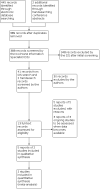
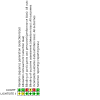
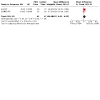
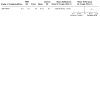
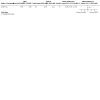
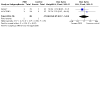
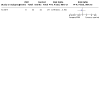
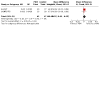
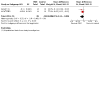
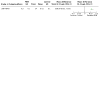
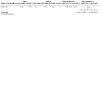
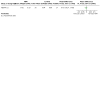
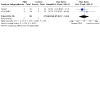
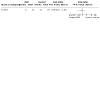
Update of
- doi: 10.1002/14651858.CD013029
Similar articles
-
Surgery for cataracts in people with age-related macular degeneration.Cochrane Database Syst Rev. 2017 Feb 16;2(2):CD006757. doi: 10.1002/14651858.CD006757.pub4. Cochrane Database Syst Rev. 2017. PMID: 28206671 Free PMC article. Review.
-
Visual cycle modulators versus placebo or observation for the prevention and treatment of geographic atrophy due to age-related macular degeneration.Cochrane Database Syst Rev. 2020 Dec 17;12(12):CD013154. doi: 10.1002/14651858.CD013154.pub2. Cochrane Database Syst Rev. 2020. PMID: 33331670 Free PMC article.
-
Blue-light filtering intraocular lenses (IOLs) for protecting macular health.Cochrane Database Syst Rev. 2018 May 22;5(5):CD011977. doi: 10.1002/14651858.CD011977.pub2. Cochrane Database Syst Rev. 2018. PMID: 29786830 Free PMC article. Review.
-
Antioxidant vitamin and mineral supplements for slowing the progression of age-related macular degeneration.Cochrane Database Syst Rev. 2017 Jul 31;7(7):CD000254. doi: 10.1002/14651858.CD000254.pub4. Cochrane Database Syst Rev. 2017. Update in: Cochrane Database Syst Rev. 2023 Sep 13;9:CD000254. doi: 10.1002/14651858.CD000254.pub5. PMID: 28756618 Free PMC article. Updated. Review.
-
Radiotherapy for neovascular age-related macular degeneration.Cochrane Database Syst Rev. 2020 Aug 26;8(8):CD004004. doi: 10.1002/14651858.CD004004.pub4. Cochrane Database Syst Rev. 2020. PMID: 32844399 Free PMC article.
Cited by
-
Considerations for the Use of Photobiomodulation in the Treatment of Retinal Diseases.Biomolecules. 2022 Dec 3;12(12):1811. doi: 10.3390/biom12121811. Biomolecules. 2022. PMID: 36551239 Free PMC article. Review.
-
Photobiomodulation efficacy in age-related macular degeneration: a systematic review and meta-analysis of randomized clinical trials.Int J Retina Vitreous. 2024 Aug 15;10(1):54. doi: 10.1186/s40942-024-00569-x. Int J Retina Vitreous. 2024. PMID: 39148091 Free PMC article. Review.
-
Multi-Wavelength Photobiomodulation Ameliorates Sodium Iodate-Induced Age-Related Macular Degeneration in Rats.Int J Mol Sci. 2023 Dec 12;24(24):17394. doi: 10.3390/ijms242417394. Int J Mol Sci. 2023. PMID: 38139223 Free PMC article.
-
Letter to the Editor Regarding "LIGHTSITE II Randomized Multicenter Trial: Evaluation of Multiwavelength Photobiomodulation in Non-exudative Age-Related Macular Degeneration".Ophthalmol Ther. 2024 Apr;13(4):1051-1053. doi: 10.1007/s40123-024-00894-2. Epub 2024 Feb 6. Ophthalmol Ther. 2024. PMID: 38319554 Free PMC article. No abstract available.
References
References to studies included in this review
ALIGHT {published data only}
-
- Robinson DG, Margrain TH, Dunn MJ, Bailey C, Binns AM. Low-level nighttime light therapy for age-related macular degeneration: a randomized clinical trial. Investigative Ophthalmology and Visual Science 2018;59(11):4531-41. - PubMed
LIGHTSITE I {published data only (unpublished sought but not used)}
-
- Markowitz SN, Devenyi RG, Munk MR, Croissant CL, Tedford SE, Rückert R, et al. A double-masked, randomized, sham-controlled, single-center study with photobiomodulation for the treatment of dry age-related macular degeneration. Retina 2020 Aug;40(8):1471-1482. [DOI: 10.1097/IAE.0000000000002632] - DOI - PMC - PubMed
-
- Markowitz SN. LIGHTSITE1: a double-masked, randomized, sham-control study with photobiomodulation in dry AMD subjects. secure.aao.org/aao/meeting-archive 2018.
-
- Munk MR, Markowitz SN, Devenyi R, Croissant C, Tedford S, Ruckert R, et al. Final analysis of LIGHTSITE I: a double-masked, randomized, sham-controlled study with photobiomodulation in dry age-related macular degeneration subjects. Investigative Ophthalmology and Visual Science 2018;59(11):ARVO E-abstract 2415.
References to studies excluded from this review
Guymer 2018 {published data only}
-
- Guymer RH, Wu Z, Hodgson LA, Caruso E, Brassington KH, Tindill N, et al. Subthreshold nanosecond laser intervention in age-related macular degeneration. The LEAD randomised controlled clinical trial. Ophthalmology 2019;126(6):829-38. - PubMed
Ivandic 2008 {published data only}
-
- Ivandic BT, Ivandic T. Low-level laser therapy improves vision in patients with age-related macular degeneration. Photomedicine and Laser Surgery 2008;26(3):241-5. - PubMed
Koev 2018 {published data only (unpublished sought but not used)}
-
- Koev K, Avramov L, Borissova E. Five-year follow-up of low-level laser therapy (LLLT) in patients with age-related macular degeneration (AMD). Journal of Physics: Conference Series 2018;992(1):012061. [DOI: ]
TORPA I 2012 {published data only}
-
- Merry G, Devenyi R, Dotson R, Markowitz SN, Reyes SV. Treatment of dry age-related macular degeneration with photobiomodulation. www.lumithera.com/wp-content/uploads/sites/7/TORPA-Clinical-Study.pdf (accessed 10 December 2018).
References to ongoing studies
NCT03859245 {published data only}
-
- NCT03859245. Photobiomodulation and ketogenic diet for treatment of mid-periphery retinal disorders for Alzheimer's disease prevention. clinicaltrials.gov/ct2/show/NCT03859245 (first received 1 March 2019).
NCT03878420 (LIGHTSITE II) {published data only}
-
- NCT03878420. Study of photobiomodulation to treat dry age-related macular degeneration (LIGHTSITE II). clinicaltrials.gov/ct2/show/NCT03878420 (first received 18 March 2019).
NCT04065490 (LIGHTSITE III) {published data only}
-
- NCT04065490. Study of photobiomodulation to treat dry age-related macular degeneration (LIGHTSITE III). clinicaltrials.gov/ct2/show/NCT04065490 (first received 22 August 2019).
Additional references
Abramov 1996
-
- Abramov MV, Egorov EA. Dependence of the efficiency of low-intensity laser therapy in involution chorioretinal dystrophy on a used wavelength. Vestnik Oftalmologii 1996;112(2):25-6. - PubMed
Altman 1996
Arden 2010
-
- Arden GB, Gündüz MK, Kurtenbach A, Völker M, Zrenner E, Gündüz SB, et al. A preliminary trial to determine whether prevention of dark adaptation affects the course of early diabetic retinopathy. Eye 2010;24(7):1149–55. - PubMed
AREDS 2001
-
- Age-Related Eye Disease Study Research Group. A randomized, placebo-controlled, clinical trial of high-dose supplementation with vitamins C and E, beta carotene, and zinc for age-related macular degeneration and vision loss: AREDS report number 8. Archives of Ophthalmology 2001;119(10):1417-36. - PMC - PubMed
Begum 2013
Berdeaux 2005
-
- Berdeaux GH, Nordmann JP, Colin E, Arnould B. Vision-related quality of life in patients suffering from age-related macular degeneration. American Journal of Ophthalmology 2005;139(2):271-9. - PubMed
Covidence [Computer program]
-
- Covidence. Version accessed 21 June 2020. Melbourne, Australia: Veritas Health Innovation. Available at www.covidence.org.
Fitzgerald 2013
-
- Fitzgerald M, Hodgetts S, Van Den Heuvel C, Natoli R, Hart NS, Valter K, et al. Red/near-infrared irradiation therapy for treatment of central nervous system injuries and disorders. Reviews in Neuroscience 2013;24(2):205-26. - PubMed
Fuma 2015
Glanville 2006
GRADEpro GDT [Computer program]
-
- GRADEpro GDT. Version accessed 22 June 2020. Hamilton (ON): McMaster University (developed by Evidence Prime). Available at gradepro.org.
Guymer 2014
-
- Guymer RH, Brassington KH, Dimitrov P, Makeyeva G, Plunkett M, Xia W, et al. Nanosecond-laser application in intermediate AMD: 12-month results of fundus appearance and macular function. Clinical and Experimental Ophthalmology 2014;42(5):466-79. - PubMed
Henein 2018
Higgins 2002
-
- Higgins J, Thompson SG. Quantifying heterogeneity in a meta-analysis. Statistics in Medicine 2002;21(11):1539-58. - PubMed
Higgins 2011
-
- Higgins JP, Altman DG, Sterne JA, editors. Chapter 8: Assessing risk of bias in included studies. In: Higgins JP, Green S, editors. Cochrane Handbook for Systematic Reviews of Interventions Version 5.1.0 (updated March 2011). The Cochrane Collaboration, 2011. Available from handbook.cochrane.org.
Ioannidis 2004
-
- Ioannidis JP, Evans SJ, Gotzsche PC, O'Neill RT, Altman DG, Schulz K, et al. Better reporting of harms in randomized trials: an extension of the CONSORT statement. Annals of Internal Medicine 2004;141(10):781-8. - PubMed
James Lind Alliance 2013
-
- James Lind Alliance Sight Loss and Vision Priority Setting Partnership. Setting Priorities for Eye Research. www.sightlosspsp.org.uk 2018.
Jobling 2015
-
- Jobling AI, Guymer RH, Vessey KA, Greferath U, Mills SA, Brassington KH, et al. Nanosecond laser therapy reverses pathologic and molecular changes in age-related macular degeneration without retinal damage. FASEB Journal 2015;29(2):696-710. - PubMed
Klein 2007
-
- Klein R, Klein BE, Knudtson MD, Meuer SM, Swift M, Gangnon RE. Fifteen-year cumulative incidence of age-related macular degeneration: the Beaver Dam Eye Study. Ophthalmology 2007;114(2):253-62. - PubMed
Kokkinopoulos 2013
-
- Kokkinopoulos I, Colman A, Hogg C, Heckenlively J, Jeffery G. Age-related retinal inflammation is reduced by 670 nm light via increased mitochondrial membrane potential. Neurobiology of Aging 2013;34(2):602-9. - PubMed
Krezel 2019
Li 2020
-
- Li JQ, Welchowski T, Schmid M, Mauschitz MM, Holz FG, Finger RP. Prevalence and incidence of age-related macular degeneration in Europe: a systematic review and meta-analysis.. British Journal of Ophthalmology 2020;104(8):1077-84. - PubMed
Macular Society 2017
-
- Macular Society. Your guide to age-related macular degeneration. www.macularsociety.org/sites/default/files/resource/Macular Society Guide to AMD accessible pdf MS002 JUN17.pdf (accessed prior to 31 October 2017).
McKeague 2014
NICE 2018
-
- National Institute for Health and Care Excellence. Low-level laser therapy for preventing or treating oral mucositis caused by radiotherapy or chemotherapy. www.nice.org.uk/guidance/ipg615 (accessed 10 December 2018).
Owsley 2006
-
- Owsley C, McGwin G Jr, Scilley K, Kallies K. Development of a questionnaire to assess vision problems under low luminance in age-related maculopathy. Investigative Ophthalmology and Visual Science 2006;47(2):528-35. - PubMed
Review Manager 2014 [Computer program]
-
- Review Manager 5 (RevMan 5). Version 5.3. Copenhagen: Nordic Cochrane Centre, The Cochrane Collaboration, 2014.
RNIB 2009
-
- Minassian D, Reidy A, RNIB. Future sight loss in the decade 2010 to 2020: an epidemiological and economic model. www.rnib.org.uk/sites/default/files/FSUK_Report_2.doc (accessed prior to 31 October 2017).
Rodrigues 2016
-
- Rodrigues IA, Sprinkhuizen SM, Barthelmes D, Blumenkranz M, Cheung G, Haller J, et al. Defining a minimum set of standardized patient-centered outcome measures for macular degeneration. American Journal of Ophthalmology 2016;168:1-12. - PubMed
Rutar 2012
Sanderson 2018
Scilley 2002
-
- Scilley K, Jackson GR, Cideciyan AV, Maguire MG, Jacobson SG, Owsley C. Early age-related maculopathy and self-reported visual difficulty in daily life. Ophthalmology 2002;109(7):1235-42. - PubMed
Sivapathasuntharam 2017
WALT 2004
-
- World Association of Laser Therapy. Consensus agreement on the design and conduct of clinical studies with low level laser therapy and light therapy for musculoskeletal pain and disorders. Available at waltza.co.za/wp-content/uploads/2012/08/walt_standard_for_conduct_of_ran.... - PubMed
Waugh 2018
Yu 2013
-
- Yu AK, Merrill KD, Truong SN, Forward KM, Morse LS, Telander DG. The comparative histologic effects of subthreshold 532- and 810-nm diode micropulse laser on the retina. Investigative Ophthalmology and Visual Science 2013;54(3):2216-24. - PubMed
Publication types
MeSH terms
Substances
LinkOut - more resources
Full Text Sources
Medical

